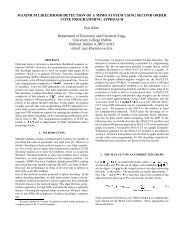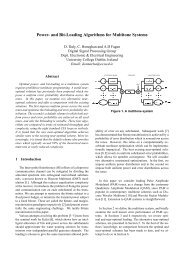Channel estimation and user-wise symbol detection for space-time ...
Channel estimation and user-wise symbol detection for space-time ...
Channel estimation and user-wise symbol detection for space-time ...
You also want an ePaper? Increase the reach of your titles
YUMPU automatically turns print PDFs into web optimized ePapers that Google loves.
E[¥[Rf(RRR¥>>@>AE[f 2fj55 >(XR2 ff/55 >E@(^¨§R9¨R¨§9'9Rconsist of the received signal from <strong>time</strong> slots to © ,at jk¤§¦ the receiver antenna.response of the £ <strong>user</strong> <strong>and</strong>gQ¥]¨§'¥"¨$% denotes the channel ¥"¨¡ SUSDSis the code vector of £¥¤§¦ the <strong>user</strong>, ""¨,-d. withX [<strong>and</strong>_ fQf ¨'h _ f ¨% _SDSDS _ f ¨©i! (4)(5)0 %1 ;is the additive noise vector at j)¤§¦ the receiver! denotes transpose operator.antenna.¨'*+For single <strong>user</strong>, the Alamouti scheme, (two transmit antennas),STBC is given bywhere © ¨is prior on . We assume that prioron is zero mean Gaussian (which can be correlatedor uncorrelated). We will use MAP method <strong>for</strong>Rchannel <strong>estimation</strong> <strong>for</strong> correlated <strong>and</strong> <strong>for</strong> Runcorrelatedcase. MAP method is superior than maximum likelihood(ML) because we take into account the prioriknowledge about the channel matrix. The probability ofchannel matrix when there are correlations both transmitting<strong>and</strong> at the receiver end is given © ¨R¨cR [by, . Where i0 ¥ ¨are correlation< ¨matrices <strong>and</strong> is a constant. Taking logarithm of Eq.10,plugging the corresponding expressions <strong>and</strong> differentiatingwith respect to givesR < f ¨§ f ¨$%( < ¨' ¨$%! ¨ ! ¨'h)( Y§*) > * (12) 2¦ §#"§$§#""&%'("(% _ f ¨§ ^f ¨$% ( _(6)Where % represents Kronecker product <strong>and</strong> vec(.) isvectorization operator. In case of uncorrelated antennaswe haveR ¦ § "¨ ! Z¨ ¨§¨ @ ¨It can be further written as ) > (13)f ¨§




